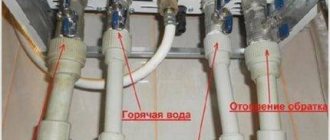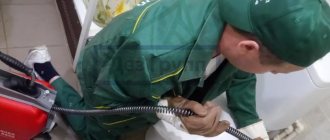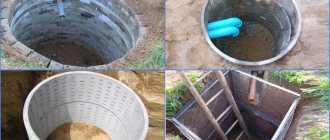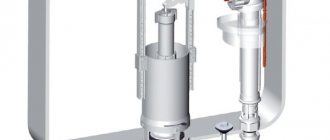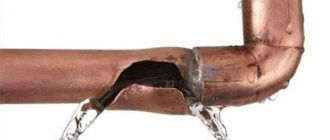If the water in your bathroom is not draining well from the toilet, this indicates that it is time to start cleaning the drain. The most important thing here is not to panic. The work is not that difficult - it’s completely possible to do everything yourself and at the same time without any special financial expenses.
In this article we will look at how to quickly and effectively solve such a problem without calling in a professional. After reading similar information and advice, you will at least decide whether you will do something yourself or whether it would be easier to take it to a plumber.
Let's start by understanding the circumstances of the origin of sewer blockages - as they say, knowing the circumstances makes it easier to deal with the problem.
Air lock is the cause of stagnation of drains
An air lock formed in the sewer system of a house can also disable the operation of the sewer collector. The air that has stopped in the system simply prevents the drains from leaving through the riser and either returns them back or passes them through, but very slowly and at the same time throws sharp unpleasant odors into the room.
The reasons for the formation of an air lock in the sewer can be as follows:
- Mistakes made when installing a plastic manifold (insufficient tightness of the pipeline, lack of connecting fittings, etc.);
- Excessive manifold turns, incorrect pipeline drops or incorrectly selected elbow angles;
- Lack of a water seal in the installed sewage system;
- Possible blockage or icing of the drain pipe in the attic or roof area.
Hydrodynamic pipe cleaning
If all known means are ineffective, it is recommended to use a special technical device with which hydrodynamic cleaning is carried out. This method is considered very effective.
Such machines differ in power and overall dimensions. It is allowed to clean pipes whose diameter can be 5-100 cm.
As a rule, all hydrodynamic devices operate on the same principle, regardless of their power and size. A nozzle is placed on the end of the device, through which a stream of water is supplied under high pressure.
The flexible hose ensures maneuverability of the device, which is important for achieving a positive result.
Some people often wonder whether it is possible to use such equipment at home and what are the costs? In answering these questions, it should be noted that to clean the sewer system in an apartment it is not necessary to buy special equipment. It’s easier to call a specialized organization. If there is a need or your financial situation allows, you can buy a mini-device for use in a country house.
Air lock problem
Nowadays, plastic pipes are very popular, which are distinguished not only by good performance characteristics, but also by easy installation. Not everyone who installs plastic pipes is a specialist, so when choosing consumables for installing a sewer system, various types of mistakes can be made. Common mistakes when choosing and installing a system include:
- incorrect determination of pipe diameter;
- unnecessary turns during the installation process;
- laying sewer pipes at the freezing level of the ground;
- lack of means in large areas to control the operation of the system.
The most difficult issue to resolve is that of an air lock in the sewer; not everyone knows how to fix this problem. If it is serious enough, then there may be a need to rebuild the entire sewer system. Before making such drastic decisions, you need to try to eliminate the problem yourself, using some simple methods.
How to get rid of an air lock?
If an air lock appears in a specific section of the pipe, for example, in the sink drain in the kitchen, bathroom or toilet, the essence of the problem may be:
- in the farthest location of the plumbing fixture from the riser;
- due to an installation error when pipes were installed with the wrong slope.
To solve such problems, you can simply re-lay the sewer sample to the riser, taking into account the correct level of inclination. In some situations, it is enough to simply raise the plumbing fixture to the required level. Thus, due to the level difference, you can get rid of problems with an air lock.
If there is an air lock in every plumbing fixture, then most likely the design of the air duct was not thought through during the installation of the system. In such a situation, it is recommended to make an open sewer riser on the roof, through which air is released from the pipeline. If this is not possible, you can install air valves that can allow air to flow in one direction.
There are situations when an air lock forms during the installation of an air duct. Then you need to check its performance.
If the measures taken to eliminate the air lock in the sewer are not successful, then the only solution is to lay new pipes.
Drain channels are clogged
The tank is filled with ordinary water, which contains mineral salts. Over time, they are deposited on the surface of the tank walls and working elements. Such growths are called hardness salts or lime deposits. Based on the fact that the drain holes are relatively small in size, lime deposits clog them, leaving a small gap for water to pass through.
In order to get rid of this problem, leave approximately 1 liter of water in the tank, but no more, and carry out chemical cleaning using one of the recipes:
- Pour 100 g of 5-7% phosphoric acid solution into the tank, and after 10-15 minutes rinse with water.
- Add 0.5 liters of borax and vinegar to the water in the tank. After 2 hours, rinse with water.
- Add 3-4 bags of ordinary citric acid to a tank of water, and rinse off after a couple of hours.
It is convenient to carry out this procedure late in the evening, leaving the acid inside the tank for the whole night.
As a preventative measure, you can install a coarse filter at the outlet, which is also the input.
If for some reason this cannot be done, then there is another way - tablets for the tank. Their effect is based on softening water and cleaning the entire drainage system. These tablets are produced by different manufacturers, but they are all quite effective.
Types of sewer clogs
If the sewer system in a house is operated in violation of all the rules for its use, then over time, blockages and plugs inevitably appear in the collector, which impede or completely stop the flow of wastewater. As a result, either someone from an apartment building or the owners of a private building will suffer from at least an unpleasant odor in the living space. The maximum possible flooding of the kitchen or bathroom with fecal water. This is not very pleasant, so to avoid such situations you need to use the collector correctly, namely:
- It is strictly forbidden to flush used personal hygiene items, such as pads, diapers, tampons, etc., down the toilet. Only flushing toilet paper is allowed.
- It is prohibited to flush bulk construction mixtures such as cement, sand, chalk, clay, etc. down the drain.
- Accidental flushing of rags and other similar items down the drain should be avoided.
- It is advisable to install grease traps in the kitchen, which will prevent the deposition of heavy greasy deposits on the walls of the collector. This, in turn, can create fecal growths-stalactites in the system and impede the flow of gray water.
It is always worth remembering that a traffic jam can form either in a specific place in the sewer system in an apartment or in a private house, or at any point in the central riser. If the last option is checked, then the drains will have nowhere to go but to return back from the blockage under the influence of hydraulic force. As a result, fecal or gray water will try to escape through the unoccupied openings of the bathtub, sink, and other plumbing fixtures.
No water comes out of the toilet. When flushing, the level rises
A classic case of a clogged drain. There was something in the toilet that was too hard or large to fit through the outlet.
First, find out what caused the blockage.
Repairing a toilet boils down to removing the plug from it; Each type of blockage has its own solution.
Construction waste, broken glass or crockery, solid food waste. The good news is that in this case the water goes away, albeit slowly. Flush several times to clear the water in the toilet. Then, alas, you will have to put on gloves and climb into the toilet
Take out the garbage carefully and slowly: cutting yourself in this case will be especially unpleasant, and sepsis is possible
Please note: flushing the last few clogged items down the drain and being too lazy to remove them is a bad idea. In this case, there is a high risk of causing a blockage down the riser.
May flood your neighbors on the first floor
In this case, there is a high risk of causing a blockage further down the riser. May flood your neighbors on the first floor.
Sand, cat litter and other soft inorganic substances. You cannot do without a plumbing cable. Use it to pierce the clog to remove it from the sewer and allow the water to flow out; the residue will have to be washed off with water from a hose or simply by flushing water from the tank over and over again and rotating the cable in the toilet. Alas, in this case we will be forced to flush the clogged item down the drain: removing it from the toilet is problematic.
A plumbing cable is one of the most useful tools in any home.
- Paper, soft food waste and other organics. There are a lot of options here: You can use the same plumbing cable;
- Chemicals for clearing clogged pipes (like Mole) or any other alkalis and acids will destroy organic matter in a couple of hours. You just need to fill them so that they come into contact with the stopper in the toilet;
- Often the blockage can be easily cleared with a regular plunger;
- In its absence, you can similarly use a large plastic bottle with the bottom cut off.
Chemistry can help in this case
Ways to solve the problem
Tools and materials to fix the problem:
- chemicals;
- plunger;
- special cable.
Use of chemicals
When using household chemicals to clear a clogged toilet, you must strictly follow the instructions and not exceed the specified dosage
. Use a substance specifically designed for cleaning pipes, for example, “Mole.” Typically, such products are made based on alkalis. The substance is poured into the toilet and begins to corrode the plug of debris and sewage that has formed inside the pipe. After falling asleep, for the procedure to be effective, you must not use the toilet for its intended purpose for several hours.
plunger
This is the simplest tool, the principle of which is to create the movement of a mass of water inside the pipes and toilet. Like a pump, a plunger pulls out some of the water and debris that has accumulated inside. The lump of plug collapses, a small gap is formed inside the drain pipe, the liquid rushes down the drain, taking with it all the debris.
Cable
The hydraulic method of removing blockages is extremely effective if the plug is formed by fatty deposits.
Most plumbers use a cable to solve this problem. It is pushed inside the toilet drain hole and pushed further along the pipe. During the process, the cable is rotated around its axis. When its end rests against the plug inside the pipe, as it rotates, it begins to twist inside the lump of debris, like a corkscrew. When the end of the cable has slightly entered the plug, when moving back and forth, the plug moves out of place and is partially destroyed. This is enough to clear the blockage inside the pipe. Afterwards, the plug is either washed down the pipe with a mass of water, or is removed out along with the cable.
If the problem is not a clogged sewer, but an incorrect design of the toilet or pipe laying, a full repair cannot be avoided.
With the help of simple manipulations, you can independently solve the problem of water obstruction in the toilet. However, if the blockage cannot be resolved using the methods listed above, you may need the help of a plumber.
The water supply is incomplete or missing
Diagram of a bowl toilet with a vertical outlet.
The toilet does not flush well even when there is little water in the cistern. As a result of the constant flow of water into the tank and the outflow of water from it into the toilet, the tank is not filled to its full extent.
A similar situation when the toilet does not flush occurs due to a malfunction of the float valve. Due to the fact that the valve is not adjusted, the water stops early. In this regard, the tank runs empty, the water simply does not have time to fill. The problem is solved by adjusting the float. Older toilet models have a brass lever that can be simply bent off. Newer models require the float to be adjusted using two plastic latches.
Flushing water will not be possible if water does not fill the tank. A similar situation when the toilet does not flush can arise for several reasons:
Float valve clogged. The valve contains a nozzle, which by its nature becomes clogged excessively quickly with small debris or limestone. To eliminate this situation, you should install the simplest filter in front of the tank. It would not hurt to install a filter directly in front of the valve at the water supply inlet. This problem can be solved step by step:
- turn off the water;
- remove the pin securing the float handle;
- remove the handle and float from the valve;
- remove any existing debris from the valve nozzle;
- open the water for a few seconds. Thus, the remaining dirt will come out along with the flow of water;
- assemble the parts into the final state.
If the blockage occurs due to a foreign object getting into the toilet and it is not possible to reach it, you must turn off the water supply and use tweezers to remove the debris.
Diagram of the drain tank.
The barrel is clogged with slag, the liner is blooming. This problem mainly affects steel pipes. In this case, you just need to clean the liner. To do this you need:
- turn off the water;
- unscrew the rubber liner of the tank;
- unscrew the valve that shuts off the water supply. In the case where a ball valve is installed, it is enough to just open it all the way;
- Point a special device into the pipe and rotate it so that the dirt comes out through it. If it was not possible to clear the blockage in this way, then with the device inside you need to turn on the water for a couple of seconds. But before doing this, be sure to place a container to drain the water. If the water comes out in a strong stream and stops, the device should continue to rotate. Then pull it out through the clogged area. After these steps, the water will flow at normal pressure.
It should be clarified that polymer and metal-plastic pipes are not susceptible to water blooming. Having paid once for reliable pipes, you won’t have to worry about fixing the problem.
Why does the sewer freeze?
Reasons for freezing sewer pipes:
incorrect design of the angle of inclination of the sewer pipeline. Water is not able to move by gravity and stagnates in the pipes, which leads to freezing in the winter;
insufficient burial depth. According to SNiP, the septic tank is installed at a depth of at least 2 meters from the soil level, the pipe system is located below the freezing point characteristic of the region. But a situation is possible when you are simply too lazy to dig a trench for laying pipes deep (or there is no possibility) or frosts exceed the average and the soil freezes deeper;
lack of insulation. Sewage pipes laid above the freezing point of the soil require insulation. The place where pipes exit the room must also be insulated. However, in practice, such a requirement is either ignored, or an unsuitable thermal insulation material is used, or its installation is carried out incorrectly;
small pipe diameter. If we consider consumer reviews, then most often those who have laid pipes with a diameter less than the recommended 110 mm are faced with the problem of sewerage freezing. Owners of summer cottages and houses that are used seasonally are especially often guilty of this. Due to insufficient diameter, the sewer pipe freezes faster;
blockages. They happen due to large objects getting into the system or insufficient water flow, which causes plaque to form in the pipes.
Causes of septic tank freezing:
The drainage from the septic tank is broken. In this case, the septic tank overflows, heavy fractions settle, and the water freezes;
the septic tank is removed from the source of wastewater. Then the water, moving to the waste pit, cools, which leads to its freezing at the junction of the pipe and the septic tank.
Many users who do the work themselves do not even think about whether the sewer system is freezing. After all, the very principle of operation of a septic tank is that it is a container for storing wastewater with actively occurring decomposition processes. Since heat is released during the decomposition of solid residues, freezing is practically excluded. In addition, according to standards, the septic tank is installed at a considerable depth.
However, no one is insured against force majeure, and it is better for the owner of a country house to know in advance what to do if the sewage system is frozen.
Tank damage
Sometimes the problem is to look for in the tank itself. Most often, the tank is damaged due to improper use of the washing machine. If people wash their shoes frequently or don't remove change from their pockets, metal objects can damage the tank.
If the seal of the tank is broken, it will have to be replaced. In this case, you need to call a technician to order a new part.
These are the most common problems that arise when operating washing machines. For a more complex breakdown, it is better to seek help from a professional.
You can install leakage protection on your washing machine. Some devices come complete with full or partial protection. With partial protection, the machine is installed on a special tray with a float and a switch. If water leaks inside the machine, the protection is activated and the machine goes into emergency mode. Washing machines equipped with full protection against leaks are, in addition to the tray, equipped with a hose with a solenoid valve that closes if a leak is detected.
https://youtube.com/watch?v=rN9seyRnj60
You should not try to fix the problem if the device is under warranty. This is a violation of warranty, and all possible consequences fall on the hands of the master.
You can fix your washing machine if it is leaking from below. Most of the reasons why this malfunction occurs are easy to eliminate. However, you should not do this without having minimal skills in working with technology.
Clogged sewer pipe
To effectively remove a blockage that has formed in a sewer system pipe, you need to buy a product containing chlorine from a specialized store. To use the drug to solve the problem of how to eliminate the smell in the toilet, you must strictly follow the instructions on the bottle so as not to harm your health. The product must be poured into the drain hole and left for a while. Most often, the blockage dissolves under the effective influence of a modern household product, and the plumbing fixture begins to function normally. If a household chemical product turns out to be ineffective, then you need to use the services of a plumber to clean the pipe.
What to do if the toilet is clogged
Everyone has encountered this situation at least once: after the next visit to the toilet, water and waste products are not flushed down the drain, and the toilet is threateningly filled with foul-smelling contents. It is obvious that there is a blockage in some area of the plumbing equipment. What to do if the toilet is clogged? How to solve this problem yourself, without resorting to the help of plumbers? What measures should be taken to prevent this from happening again? We will talk about all this in this article.
Related article: The toilet is broken
Defrosting sewerage work procedure
If a problem arises and the sewer system in a private house is frozen, you must first determine the location of the ice jam.
Craftsmen note the importance of following the order of work, and it is better to start from the place where the water exits the septic tank. This order of work is due to the fact that the sewer pipe system is designed with the obligatory condition of ensuring unhindered flow of water
This means that all pipes, incl. The drain pipe is located at a slope to the exit point.
Ice plugs must be melted so that the water can drain naturally. Otherwise (when performing work outside), you need to be prepared for the drains to flow in the opposite direction, which will necessitate pumping them out. This convincingly proves that work should begin in the direction from the septic tank to the internal pipes.
But there are exceptions to this rule. Ultimately, the order of work will be determined by factors such as:
the location where the ice plug forms. If the water is frozen in the inside of the sewer (unheated house), then it will be much easier to defrost;
cork sizes. Perhaps the size of the ice plug will be only a few centimeters, then the volume of water that needs to be pumped out can be neglected;
geometry of the sewer system. The more straight sections in the system, the easier it is to remove the ice plug;
laying method. Typically, sewerage is located underground. And if ice has formed in pipes located at a sufficient depth under a layer of frozen earth, the number of options for use is sharply reduced. You can’t get through the septic tank - you have to carry out work from inside the house.
The easiest way to organize the winter functioning of the sewer system is to contact specialists who provide sewer defrosting services. The craftsmen not only know how to defrost a frozen sewer, but also have special equipment and also provide a guarantee on their work. However, for various reasons, many people prefer to solve the problem on their own. And as reviews from forum members testify, it was quite successful and fast.
Ways to fix sewer problems
In order to try to remove a blockage in the sewer drain of an apartment or house, you must first determine the location of the blockage.
So, if a problem with water outflow is observed in the kitchen sink, and all other drain points are working normally, it means that the garbage plug has formed specifically in the siphon under the sink. In the same way, you can identify blockages under the sink in the bathtub or under the bathtub/shower stall itself. Depending on the location of the plug, chemicals such as “Mole”, etc., can be poured into the drain hole in accordance with the instructions and eliminate the problem of deposits on the pipes.
- As an aggressive anti-clog agent, you can use simple soda mixed with hot water. That is, first pour soda into the hole in the bathtub or sink, then fill it with hot water. After this, vinegar is poured into the hole. The reaction of the components should push the plug or simply liquefy it.
- You can also use a standard plunger to remove a blockage in your home drain. Cleaning is easy with it. You need to fill the plumbing fixture with water and tightly cover the drain hole with a plunger. Now you should make rhythmic movements up and down with the plunger, creating a vacuum in the manifold. Under its influence, the plug should either come out (most often it is hair) or go into the waste system. You can clean the sink and toilet in a similar way.
Manually removing a stuck object
Sometimes the stuck object is not too far into the toilet siphon and can be pulled out by reaching with your hand. If you have fairly thin hands and you don’t faint at the thought of putting your hand “in there,” you can try to feel around inside the toilet with your fingers and perhaps you will be able to hook your finger on a stuck rag, sock or other object and pull it out.
Unfortunately, it is not always possible to deal with blockages so easily. Then you have to destroy the blockage in other ways.
How and how to defrost a sewer in a private house
There are different ways and means to warm up a frozen sewer (than to melt the ice in a pipe). All methods can be combined into two large groups:
thermal method. Provides for the organization of heat supply to the freezing point. The work is progressing slowly, but there is no risk of causing damage to the pipeline system. This method is most suitable at home, when special means are not at hand, and calling specialists is impossible or too expensive;
chemical method. Currently, chemical defrosting is rarely practiced. Firstly, because not every chemical can cope with icing. Secondly, because this is a costly method. And thirdly, because many users prefer local sewers, i.e. systems that are capable of performing partial wastewater treatment.
Mellerud pipe cleaner, chemical defrosting One of the components of local systems is the presence of biological treatment, and chemistry can negatively affect the life of bacteria. However, its simplest variety, a steep saline solution, is still used, according to reviews.
A more technologically advanced option is to use a drug like Mellerud. The components of Mellerud pipe cleaner react with water to produce heat.
Note
You should carefully use a chemical method to defrost plastic sewer pipes. Because
Severe overheating can cause them to deform.
What kind of blockages can there be and how to determine their cause
All sewer blockages are divided into several types:
- adhesion of fat to the internal surfaces of the pipe and adhesion of other waste. Such a blockage is usually called operational;
- the mechanical appearance differs from the previous one in that the cause of clogging is the entry of a foreign object into the system;
- as a result of the appearance of a fatty layer, a siphon blockage may occur;
- There is also a man-made problem, the cause of which is an error during installation of the system.
If the main access riser on the lower floor becomes clogged, then all the contents in the pipe rise up and come out in someone’s toilet, bathroom or kitchen. In such situations, you need to urgently call a specialist, since it is unlikely that you will be able to fix the problem yourself.
Finding an air lock in a sewer pipe
Ways to solve the problem
You can use regular soda to clean drains. To dilute the correct solution, you need to prepare several liters of boiling water in which a pack of soda will dissolve. The prepared liquid should be poured into the drain hole, and it is recommended to gradually add vinegar. In this way, a reaction can be achieved that will promote the rapid decomposition of fat
Most often, this method is used if there are no special means at hand, which include Mole, Tiret, etc. You can use chemicals yourself, but it is important to follow basic safety rules. Immediately before cleaning the sink, toilet or bathtub, you need to familiarize yourself with the operating instructions for a particular product.
It is better to use this cleaning method when the pipe is not yet completely clogged, this way you can achieve greater efficiency. When the drain is completely clogged, it is dangerous to use chemicals because they can back up into the bathtub or sink. A proven and reliable method of cleaning is to use a simple plunger. When actions using soda or chemicals do not bring much effect, then this method can be used. In such cases, it is important that the bowl of the plunger completely covers the drain hole.
How to fix the problem using a plunger?
Actions are performed in a certain sequence:
- a sample filter is removed from the hole;
- the top hole of the bathroom must be tightly closed to achieve greater efficiency during the work process;
- The plunger must be installed so that no air lock appears, while the handle is placed vertically;
- without lifting the device from the bottom of the bathtub, you need to move the device up and down;
- on the last movement, the plunger rises from the water to check the effectiveness of its drainage. If necessary, the procedure is repeated several more times.
Another proven device is a metal cable, which is often used by plumbers. At one end of such an object there are fluffy wires, on the other side of the cable there is a handle for convenient use. The first end is inserted into the pipe, and rotational movements must be made using the handle. Depending on the degree of pipe clogging and the location of the problem, cleaning can take a relatively long time. If the problem is solved quickly, then the length of the cable is sufficient to effectively penetrate the sewer.
Let's sum it up
As you can see, there are not many reasons why water may leak in the toilet. Therefore, in principle, even an untrained person can cope with the problem.
It is only important to carefully read the instructions and act consistently and carefully. Then everything will work out - the toilet will work without failures. Is your toilet tank leaking? Well, let it flow - it’s not the biggest problem
After all, the flowing water will still flow into the sewer. And many homeowners think so. Until you receive a bill for your water consumption
Is your toilet tank leaking? Well, let it flow - this is not the biggest problem. After all, the flowing water will still flow into the sewer. And many homeowners think so. Until they receive a bill for the water consumed.
After this, they come to a belated understanding of the danger of the situation when your own money flows from the tank into the sewer, almost before your eyes. Therefore, a leak in the toilet flush tank must be repaired immediately, immediately after discovering this defect in the operation of your plumbing equipment. And in this article we will tell you how this is done.
How to fix a leaking toilet cistern if you are not familiar with its design? Of course not. Therefore, before reviewing the repair technology, we will dive into the structure of the object being restored.
A typical tank consists of the following elements:
- Float valve (faucet)
- a fitting connected to the water supply system, on which a shut-off unit controlled by a float is attached. If there is no water in the tank, the float pulls the valve shut-off element down, opening the fitting. When the tank is filled, the float rises up, closing the fitting. - Overflow
- a hollow column connected to the toilet. This column protects the tank from overflowing. When the water level reaches the edge of the column, the liquid will overflow into the toilet rather than rush into the toilet room. - Drain valve
- a hatch mounted on a hinge that closes the drain hole leading to the toilet. If the hatch is closed, water from the float valve fills the tank. If the hatch is open, then all the liquid accumulated in the tank flows down the drain hole into the toilet.
drain lever
– drain valve control mechanism. This unit consists of a rack with a rocker arm, the edge of which is connected to the valve (hatch) with a polymer or metal chain. By pressing on the free edge of the rocker, you pull the chain up and open the valve hatch. By releasing the lever (yoke), you loosen the chain and lower the hatch into place.
Of all the components described above, only the first three elements can provoke a leak in the toilet - tap, overflow, valve. Therefore, repairing a toilet cistern leak involves restoring the functionality of these particular components.
.
As you can see: there is nothing complicated in the design of the drain system. But enough theory, it’s time to move on to repairs.
Where to start the renovation?
Of course, starting with finding the cause of the water leak. After all, only by understanding why the toilet tank is leaking will you be able to eliminate the defect and establish normal operation of the drainage structure.
And there may be several reasons for this, but most often plumbers deal with the following options:
The first option is a leak through the overflow
– Diagnosed very simply – water is constantly flowing in the toilet cistern. It’s as if we have a bottomless structure in front of us, and not a container of 10-12 liters (or even less). Therefore, if you hear the murmur, get ready to change or repair the parts of the float valve.
The second option is a defective sealing gasket.
– noticeable by a constant stream that forms a characteristic limescale “drip” on the inner surface of the toilet bowl. If you see it, get ready to dismantle the tank and change the gasket.
The third option is a weakened drain valve.
– diagnosed by an intermittent stream flowing from the drain nozzles into the toilet bowl as water enters the tank. Therefore, if, while filling the container, water flows from the tank into the toilet, without any options, get ready to change the valve shut-off element.
As you can see: there are not so many prerequisites for the formation of a leak. However, each of them requires its own approach to repair. Therefore, next we will consider three technologies for eliminating leaks, linked to three reasons for its formation.
Other interesting questions and answers
What happens if during a fire you close yourself in the bathroom and, opening the water, flood everything around you?
Alina Boldt3
Makes a good broth
Well, in order to fill out 140 characters, I can advise you to pour salt and spices to taste into the bath in advance. You can throw in a bay leaf.
Nekit Ganbarov118
How do you feel about those people who left your life? And were there such people?
Guest7
Well, it depends on what kind of people, if they didn’t mean much to me, then I treat it calmly, and if they were my everything, then tears and tears and tears. Yes, there are quite enough of such people, but still this is life, and this will happen all the time. We’re not in the right to hold someone back and force them to stay with us if they no longer want it. Of course it will hurt, because when a loved one leaves, it feels like a part of you is simply dying. It’s like you’re broken and don’t feel anything. But with time it will pass. Maybe. everything has to pass someday. but in order for people not to leave, you just need to appreciate them and give yourself to them completely, simply because one day this person will not be around, and you will be ready to give everything, just to once again, at least for feel him next to you for a couple of minutes, smell him and just hug him and tell him how important he was to you. ummm61
Why does the bathtub occasionally smell like sewage?
There are no blockages in my apartment bathroom. The house is five-story. I live on the fifth floor. I contacted the plumbers, but they didn’t really say anything. You can hear the flushing in the riser on the lower floors, and the gurgling in the pipes in the bathtub. They explained that this was due to the automatic washing machine. I can't understand this connection. How to write an application, what exactly do you require?
P.S. Men, please tell me what to do?
nikumarina20112
I'm not a man, but I'll give you a hint. I live on the fifth floor, and this sometimes happens. My husband and I have been looking for the reason for this phenomenon for a long time, but it turned out to be quite simple and well-known. You can observe (or rather smell) this phenomenon only in winter, during severe frosts. It is also typical for the 4th floor, and indeed for the upper floors. This is due to the fact that sewer flows are uneven. At night, practically no one drains the water, especially warm water. Everyone is asleep, as you might guess. And those drains that are present carry mainly cold water from the cisterns. If the frost is severe, then a small amount of ice will form in the lower sewer pipes. The cross-section of the pipe opening decreases. When water is drained, this leads to a flow of air following its flow. He, like a vacuum cleaner, sucks out the water standing there from the knee under the bathtub or sink. It serves as a water seal and prevents the penetration of odors from the pipes. You simply don’t notice it, but you immediately smell it. As the air gradually heats up, it rises up through the pipes and comes out of the drain hole of the sink or bathtub. In the morning, people start pouring warm water, and everything returns to normal. To avoid this, you just need to drain some water into the sink or bathtub in the evening. Literally a couple or three glasses. If the water drains relatively slowly, it will not go down the drain, but will remain in the water seal, where it should be. There will be no smell. Tested many times.
Andreeva6
I am very nervous when the gases in my intestines begin to boil, drill, jump and scream heart-rendingly...
I noticed that this happens to some people when they want to go to the toilet.
But for me it’s always whether I went or didn’t go, it doesn’t matter... If there’s a person nearby, that’s it... Run for your life. Otherwise, such a symphony will begin that it will be heard at 50 meters
And I'm not kidding. Why do I need this? And how can I get rid of it? As a result, I am tormented by a bunch of complexes and blocks. I avoid people myself so as not to embarrass myself once again. I sit at home and suffer... And they consider me abnormal. I was poisoned by worms. I took strong drugs. But nothing has changed. Guest5
I tried not to eat foods that caused gas. Also this year I took a course of Normobact. The result turned out to be pleasant, I can now eat a pickled cucumber with dinner and a cabbage salad
Guest1
Why, when the apartment upstairs is flushed, does the water in the toilet downstairs also drain?
What you described is correctly called a water seal failure.
The water seal is the water standing in the toilet opening and in the siphons of the bathtub and sinks. This water seal prevents odors from the sewer from rising into our apartment.
Why does he break down? Because the top of the drain pipe (the thick pipe in the toilet that runs through all the floors and goes out to the roof) is clogged. In winter it can become clogged with snow and ice. In the summer - maybe they shut it up with some hooligans. Call your management company (housing office, or whatever it is called), explain the situation, the plumbers will go up to the roof, clean the pipe and everything will work out.
the system chose this answer as the best
In multi-storey buildings, the sewage system is designed in such a way that the toilets of all adjacent bathrooms (from the top to the first floor) “hang” on each central riser. Moreover, in order to prevent a vacuum from forming in the riser when draining water (the water moves down like a piston, creating a rarefied space behind it), the upper end of the riser is brought to the roof and a valve should be located at its top point (sometimes there is simply a rain fungus instead) ), preventing air from escaping from the sewer, and, on the contrary, allowing air to enter inside it, just to relieve the vacuum during flushing. If the valve is faulty or the upper end of the riser is clogged, then what you described in the question happens. You need to call a plumber and have him provide air access to the drain.
add to favorites link thank
Methods for eliminating air locks
Removing plugs using an installed air vent
Before removing the air lock in the heating, you need to find out its properties. The main one is density, which will always be lower than the same indicator of water. Accordingly, the liquid will displace air upward and in the direction of circulation.
Therefore, to remove air, it is necessary to ensure the release of steam. To do this, you should install special devices - air vents and Mayevsky taps. They work on the principle of a check valve. When a certain pressure is exceeded, steam acts on the valve seat. The rod moves, releasing air from the radiator or pipe. After the pressure normalizes under the action of the spring, the rod takes its old position.
An air lock in a cast iron or aluminum radiator can damage the housing. Therefore, when such a situation arises, you need to solve the problem immediately.
Leaking toilet tank
Fixing the problem of a leaking tank is a completely doable task, but quite troublesome. First you need to look at the reasons for this problem:
Related article: Main types of upholstered furniture
Diagram of the drain tank.
- The bulb seat is clogged. It needs to be cleaned.
- Deformation, wear of the pear. Complete replacement of the pear. They are sold freely in plumbing stores.
- Destruction of steel (plastic) bolts. Because of this, water flows through the holes to the shelf. In this case, it is possible to either replace the damaged bolts or completely replace the complete set.
- Float deformation. In this case, the float allows water to pass through, loses its tightness, and its weight increases. As a result, it sinks, which affects the operation of the toilet. To solve the problem, you need to dismantle the float and install a new one. If it is impossible to make a replacement, it is necessary to seal the damaged float. Sealing is carried out using plastic, which fills the cracks in the molten state. After which the float is placed in a plastic bag and attached to the lever.
- Damage to the siphon membrane. In this case, the membrane should be replaced.
To do this you need:
- drain water;
- unscrew the nuts securing the tank to the flush pipe;
- slightly unscrew the siphon nut at the base of the cistern;
- dismantle the siphon;
- change the membrane;
- assemble the parts in the appropriate order.
Reasons for the formation of air jams
The finished closed-type heating system is sealed, but this does not guarantee the absence of air bubbles. Where does the gas in pipes and radiators come from?
Air appears in the heating system for the following reasons:
:
- The coolant is tap water that has not undergone special preparation - when heated, air dissolved in the water begins to release, and plugs form from small bubbles.
- The tightness of the system is broken, and air is gradually sucked in through loose connections.
- During the repair work, part of the circuit was disconnected by shut-off valves, some elements were replaced or cleaned, and then the coolant was again supplied to the repaired circuit.
- The pipeline was laid in violation of standards - the small angle of inclination of the pipes and improper installation of kinks prevent gas bubbles from entering special devices - air vents. As a result, gas accumulates in problem areas and interferes with the normal circulation of the coolant.
- If the heating system of a private home fills up very quickly (or when the coolant supply is not at the lowest point), the liquid is not able to completely displace air from complexly configured places in the pipeline and radiators.
- Air vents are missing or incorrectly positioned. Also, the reason for the incorrect operation of the air bleed device is its contamination by mechanical inclusions in the unfiltered coolant.
Separately, it is worth considering gas formation in aluminum radiators. When metal comes into contact with a slightly alkaline coolant, hydrogen is released, which accumulates at the highest point of the heating device. If the radiator is not equipped with an air vent, over time the gas lock will not allow the coolant to pass freely through the internal channels of the heating device.
Damage to enamel
Ceramic toilets, the most common, are coated with a smooth glaze or enamel
Over time, the coating wears out, and when struck by carelessness, scratches, chips and cracks remain on it. As a result, the smooth surface turns into a rough one and begins to resist the flushing of sewage.
Damage to the enamel is a sure sign that it is time to purchase a new toilet, but if there is no opportunity to do this yet, they resort to temporary restoration:
- After rinsing and drying the toilet, rough areas are treated with fine-grained sandpaper;
- thoroughly wash the toilet so that no dust remains, then dry and degrease;
- waterproof sealant or ceramic putty is applied to problem areas;
- after waiting for the mixture to dry completely, paint the treated areas with powder paint using a paint gun;
- wait for the paint to dry completely (about 3 days are required) and resume operation of the device.
The improvised glaze does not last long, so it is recommended to plan to purchase a new toilet in the near future.
Bleeding air in radiators
So, first of all, you should focus on bleeding air from heating devices - radiators. In this case, you should use the already proven option: bleed the air through the Mayevsky valve. This tap is usually installed instead of blind plugs on the radiator, at the highest point. This arrangement implies the accumulation of excess air directly under the valve. In other words, when it opens, the first thing that will come out is air, and then water will come out, which will indicate that the plug in the heating system has been completely eliminated.
To do this, you just need to place a container into which a small amount of liquid will be poured out along with the air. Open the tap and wait until only water comes out, without the characteristic sounds of air bubbles.
Heating system without air locks
To ensure that air in an individual heating system does not accumulate in problem areas, but goes outside, it is necessary:
- correctly design and install the pipeline, correctly install radiators;
- use automatic and manual air vents.
Let's look at how to expel air from a heating system with natural circulation and top wiring
When arranging a pipeline, it is important to maintain an inclination angle at which air bubbles move freely upward, to the highest point of the circuit, without accumulating at turns and flat areas. At the highest point of such a system, an open-type expansion tank must be installed, through which air bubbles enter the atmosphere
To bleed air from a system with forced movement of coolant or a gravity system with bottom wiring, a different principle is used
. Return pipelines are installed at a slope (this simplifies draining liquid from the system), and at the top point of all individual circuits, automatic valves are installed through which air is discharged as it accumulates.
In addition to automatic air vents, the system also uses manual Mayevsky valves. Such air vents are mounted on heating radiators - on the upper pipe on the opposite side of the pipe supplying the heated coolant. To ensure that air enters the valve and does not accumulate in the upper radiator manifold, it is recommended to install the heating device at a slight angle. Air release is performed manually as needed.
How to find an air lock?
Ideally, the system independently copes with airing thanks to automatic valves through which air is released. If you discover that a particular heating device or part of the circuit is not working properly, you need to find the place where the air has accumulated.
Touch the radiator - if its upper part is colder than the lower part, it means that coolant is not flowing there
. To release air, open the Mayevsky valve installed on a steel, aluminum or bimetallic radiator, or the valve valve mounted on cast iron batteries.
You can also determine the location of airing by sound - under normal conditions, the coolant moves almost silently, extraneous gurgling and sounds of overflow occur due to an obstacle in the flow
.
Metal pipes and heating appliances are tapped with light blows - in places where air accumulates, the sound is noticeably louder.

